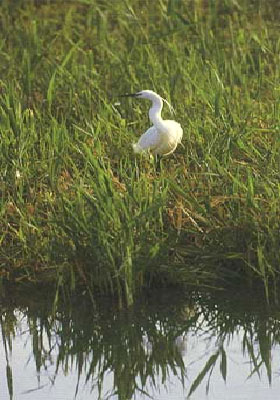Azraq is a unique wetland oasis located in Jordan’s eastern desert, 110 km east of Amman close to the Iraqi border. It is the only permanent natural wetland Waterbird Reserve in Jordan. Its attractions include several natural pools and ancient man-made pools, a seasonally flooded marshland, a large mudflat known as Qa' al-Azraq, a rare Umayyad dam. Established in 1978, Azraq Reserve is one of the oldest reserves managed by Jordan’s Royal Society for the Conservation of Nature (RSCN).
It covers 12 square kilometers of marshland. It is a staging area for migratory and nesting birds on their migration routes between Europe and Africa.
The site is composed of marshy area, mudflats, and waterpools in a depression at 500-600m altitude. It is a breeding ground for some 70 species of raptors and waterbirds.
A total of 18 species of mammals including the wolf, the caracal, and the wildcat and striped hyena are found in Azraq, as well as 15 species of reptiles and two of amphibians. Of the eight species of fish, only the Azraq Killifish is endemic. About 150 species of plants have been recorded in the reserve, five of which are globally rare.
The reserve offers wooden trails through the marsh, a hide for watching birds and a visitor center.
The oasis once had the only abundant permanent freshwater springs in the surrounding desert and has supported a long and varied human history. The Azraq region marked the eastern boundary of the Roman Empire and a few Roman, Byzantine and Umayyad structures are located within the site.
Two permanent communities with a population of 4000 people are within the site: North Azraq, founded after World War I by the Druze community, and formerly called Druze, and South Azraq, established in 1920s by the Chechen form the Caucasus, formerly called Shishan, as well as a military base. Qasr Azraq is one of the historic desert castles, located in the village of North Azraq. During World War I, when T.E. Lawrence, better known as Lawrence of Arabia, used the castle as his military headquarters during the Arab revolt against the Turks.
More recently nomadic Bedouins depended on the wetland for their livelihood, but the Bedouins remaining in the area no longer have access to the wetland. The interstate highways running between Amman, Syria, Saudi Arabia, the Gulf, and Iraq, skirt Azraq, and as can be expected the level of human activity is high.
One threat to the wetland reserve comes from excessive groundwater extraction: Azraq’s water is pumped for use as the main water source for the capital city, Amman. By 1990 unsustainable groundwater extraction led to the almost complete desiccation of the site. A physical rehabilitation by reverse-pumping water from one of Amman’s pumping stations back into the Azraq site has slowed salinization and revived the wetland habitat. It has also spawned a local community organization, the Friends of the Azraq Society, which promotes conservation and sustainable development and addresses the social and economic concerns of the people living in the vicinity.
Other threats come form agricultural expansion, excessive disturbance by hunters, herders and livestock.
Ramsar site no. 135.
The Ramsar Convention on Wetlands came into force for Jordan on 10 May 1977. Presently, Azraq is Jordan’s only site designated as a Wetland of International Importance, with a surface area of 7,372 hectares.
References:
http://www.rscn.org.jo/;
www.ramsar.org;
http://www.birdlife.org/;
http://www.wetlands.org/RSDB/_COP9Directory/Directory/ris/2JO001en.pdf
Photos: http://www.rscn.org.jo/photoGallery.asp?language=&pageIndex=4





